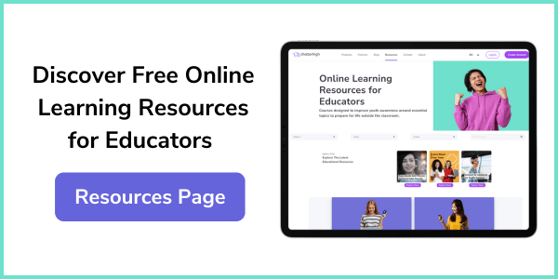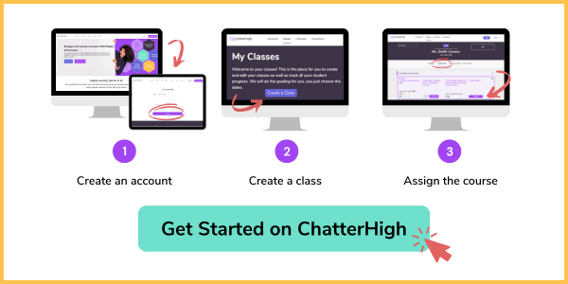How ChatterHigh Supports Different Learning Styles
by Tanvir Kaur on 21 Feb, 2025
Education isn’t a one-size-fits-all approach. Each student has their own unique way of processing and retaining information, and as an educator, you understand the importance of connecting with each of them in a manner that makes learning memorable. By recognizing and embracing different learning styles, you can foster an engaging and inclusive classroom environment that enhances students' ability to absorb and retain knowledge.
| Topics Covered: |
Understanding Learning Styles and How to Support Them
Learning styles refer to the various ways individuals prefer to take in and process information. While many students may utilize a combination of styles, understanding the distinct types can help you tailor lessons to accommodate diverse needs. Here’s a breakdown of eight common learning styles along with strategies to support them:
-
- Use infographics, diagrams, and mind maps
- Incorporate videos and interactive presentations
- Highlight key information with color coding
- Auditory Learners – They learn effectively through listening and engaging in discussions.
-
- Use storytelling, lectures, and audiobooks
- Encourage group discussions and debates
- Introduce educational podcasts
- Read/Write Learners – They prefer written words and structured text.
-
- Assign reading materials and written reflections
- Encourage note-taking and summarizing concepts
- Provide blogs, articles, and written case studies
- Kinesthetic Learners – They thrive through hands-on experiences.
-
- Plan experiments, lab activities, or role-playing exercises
- Incorporate real-world applications and field trips
- Use interactive learning tools and simulations
- Verbal Learners – They excel at expressing ideas through words.
-
- Assign presentations and encourage peer teaching
- Use poetry, storytelling, and creative writing activities
- Incorporate speech-based exercises like debates
- Analytical Learners – They thrive on logic, reasoning, and problem-solving.
-
- Assign tasks that involve data analysis and critical thinking challenges.
- Utilize case studies to promote deeper exploration.
- Incorporate logic puzzles, coding exercises, or math-related activities.
- Social Learners – They excel in collaborative and group settings.
-
- Facilitate projects that require teamwork and peer discussions.
- Encourage cooperative learning through games.
- Implement role-playing and group brainstorming sessions.
- Solitary Learners – They favor self-paced, independent study.
-
- Provide access to self-guided online courses.
- Create quiet study areas for personal reflection.
- Assign independent research projects.
Since students often exhibit multiple learning styles, a multimodal approach—integrating various methods—ensures a more effective learning experience.
The Power of Multimodal Learning
Multimodal learning integrates different teaching techniques to engage students through various senses. A single lesson might include:
- A video (visual)
- A class discussion (auditory)
- A reading assignment (read/write)
- A hands-on activity (kinesthetic)
This method not only improves comprehension but also enhances retention, making learning more engaging and effective for all students.
How ChatterHigh Supports Multimodal Learning
ChatterHigh is a free platform that promotes multimodal learning by engaging students in topics like career exploration, financial literacy, science & environment, etc., with gamified learning modules and interactive quizzes. Here’s how it caters to different learning styles:
- Visual Learners: The platform includes gamified quizzes that guide students to various trustworthy webpages with infographics, diagrams, and videos. The interactive design allows students to navigate information easily while making learning visually stimulating.
- Verbal Learners: It encourages classroom discussions, peer interactions, and verbal engagement about reflection on their interests.
- Read/Write Learners: Students explore reputable webpages, articles, and case studies to research answers to quiz questions. This approach encourages reading comprehension and reinforces retention through written explanations.
- Analytical Learners: ChatterHigh’s quizzes require students to critically evaluate information, analyze different career paths, and draw connections between their interests and potential careers.
- Social Learners: National and regional competitions foster collaboration, school spirit, and peer engagement.
- Solitary Learners: Since ChatterHigh quizzes are available anytime, anywhere, students can engage independently, exploring career paths at their own pace.
Did you know that a student’s preferred learning style can also play a significant role in shaping their career choices?
Linking Learning Styles to Career Choices
A student's individual learning style can impact their career path. The connection between learning styles and career choices can spark meaningful classroom discussions, helping students reflect on their interests and post-secondary options. Knowing their strengths can assist them in making career decisions. For instance:
- Visual learners could be more capable at careers such as graphic design, architecture, or data analysis, where information is to be interpreted visually.
- Auditory learners could be well adapted to careers such as journalists, musicians, or counselors, where verbal communication and listening are key.
- Kinesthetic learners could be interested in the skilled trades, physical therapy, or culinary arts, where action with the hands is needed.
- Analytical learners could be drawn to careers such as engineering, computer science, or finance, where problem-solving and logic are paramount.
How ChatterHigh Supports Career Exploration
Let’s face it—many students have no idea just how many career options are out there. Without exploring, they might believe there are fewer, only well known options for them (like doctor, police officer, or engineer) and miss out on roles that could be a perfect fit for their interests and strengths.
Learning style and career selection have a strong relationship. Once students discover careers that match the way they learn best, they're more likely to excel and remain motivated in their chosen paths. ChatterHigh bridges this gap seamlessly by integrating career exploration with interactive multimodal learning activities.
By learning through real-world, reputable sources, students learn more about their interests and strengths. This gives them greater confidence in their future decisions. Whether it’s through gamified quizzes, career exploration, or national competitions, ChatterHigh makes learning both fun and meaningful.
Learn about ChatterHigh’s available activities and free resources for your classroom: 


